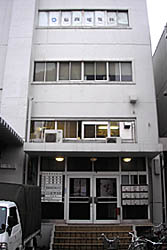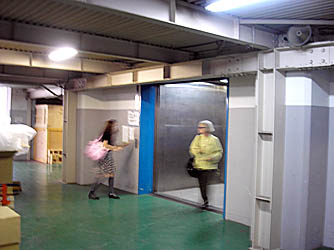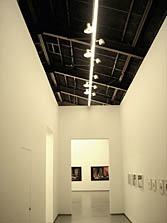 |
|
Here and There introduces art, artists, galleries and museums around Japan that non-Japanese readers and first-time visitors may find of particular interest. The writer claims no art expertise, just a subjective viewpoint acquired over many years' residence in Japan.
|
|
 |
|
|
 |
 |
Tokyo's Contemporary Art Mecca: The Maruhachi Warehouse
Alan Gleason |
 |
 |
View of the Maruhachi Warehouse from the Sumida River.
The galleries occupy the upper floors in the back. |
|
Tokyo has plenty of warehouses and warehouse districts, but few have been amenable to conversion into funky art spaces as in lower Manhattan or San Francisco's South of Market. The endless cycle of real estate boom and bust in this megalopolis has force-marched contemporary art galleries on a nomadic quest for cheap, roomy, unorthodox spaces in industrial settings.
For nearly twenty years, from 1983 to 2002, the one-stop contemporary art spot in Tokyo was the Shokuryo Building, an old three-story brick warehouse -- originally for rice -- that housed numerous galleries and studios in the Sagacho district next to the Sumida River. When the building was closed for demolition (to be replaced by condos), several galleries moved across the river to Shinkawa, where they settled into a smaller warehouse until 2005 -- when that, too, fell to the wrecking ball (more condos).
Third try appears to have been a charm, however, as the core of the Shinkawa group once again crossed the river en masse, this time to Kiyosumi, just north of Sagacho, and took up residence in the most unlikely of settings yet: the top three floors of a gargantuan, still functioning warehouse, the Maruhachi, hard by the Sumida. While trucks rumble in and out of the loading docks on the ground floor, intrepid art lovers negotiate their way among pallets of cargo in search of the one freight elevator that stops at the gallery floors. The presence of some of Japan's most prestigious contemporary art venues on floors 5, 6 and 7 is indicated only by an art poster or two on a warehouse side-door and a hand-lettered sign down the hall announcing, "Only this elevator goes to the galleries."
The timing of the Maruhachi galleries was in fact quite fortuitous, in that they established themselves in their new quarters just in time to enjoy a contemporary art boom in Japan that only began to subside with the recession in late 2008. Initially there were eight (four of whom had moved there from Shinkawa); two have since moved to other parts of Tokyo, but six remain, and none have gone out of business to date.
The undisputed flagship of the group is the Tomio Koyama Gallery, frequently touted as Japan's foremost contemporary presence on the international scene thanks to its championing of artists Takashi Murakami and Yoshimoto Nara. Koyama occupies the entire top floor and utilizes it to maximum effect. There is no ceiling; white walls extend only part way to the rafters of the peaked warehouse roof high above. Koyama may well be the roomiest private gallery in the country. On the day I visited, the multi-room space was filled with large photographic works by the American artist Laurie Simmons.
One floor down, hiromiyoshii occupies smaller, lower-ceilinged, but similarly stark white rooms. On this visit one room held some cryptic abstractions by London-based artist Martin Creed, while another offered what seemed like a parody of contemporary video art: a loop of a woman vomiting on a gallery floor. Meanwhile, on the fifth floor, the Taka Ishii Gallery was celebrating the opening of a solo exhibition by the notorious photographer Nobuyoshi Araki. Titled "69YK" to commemorate Araki's 69th birthday, the new series leans heavily toward crotch shots of nude women in rope-bondage gear, with a few close-ups of plastic monsters and kittens thrown in for good measure.
Rounding out the Maruhachi Six are ShugoArts (see this month's Picks), Miyake Fine Arts, and Kido Press. Unfortunately for the tired and thirsty gallery-goer (particularly after a few passes around the Maruhachi in search of the elusive entrance), the Magic Room Café has recently moved elsewhere, and there are no eateries to be found nearby. Best to retrace one's steps to the Kiyosumi-Shirakawa metro stop, and pay a visit to the lovely Kiyosumi Gardens en route.
The good news is that the surviving galleries seem to be weathering the current recession with aplomb, good humor, and cautious optimism. One can only hope that the owners of the Maruhachi do not sell their property to yet another condo developer anytime soon.
 |
|
 |
| The unprepossessing entrance to the Maruhachi galleries, next to a loading dock, signified only by a couple of art posters on the door. |
|
Intrepid art lovers enter and exit the well-hidden freight elevator leading to the galleries. |
|
 |
|
 |
The ceiling-less Tomio Koyama Gallery on the top floor, with the warehouse roof directly overhead.
Photographic works by Laurie Simmons are in the background.
© Laurie Simmons; photo by permission of Tomio Koyama Gallery. |
|
The main gallery space at hiromiyoshii on the sixth floor, with Martin Creed's paintings on exhibit.
© Martin Creed; photo by permission of hiromiyoshii.
Photos by Alan Gleason
|
|
|
|
|
|
|
 |
 |
Alan Gleason
Alan Gleason is a translator, editor and writer based in Tokyo, where he has lived for 25 years. In addition to writing about the Japanese art scene he has edited and translated works on Japanese theater (from kabuki to the avant-garde) and music (both traditional and contemporary). |
|
|
|
 |
 |
|